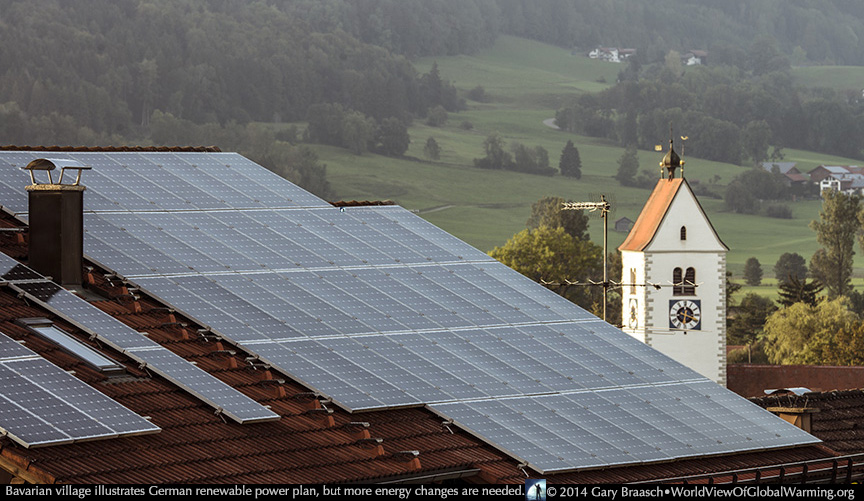NY Times cover story illustrates the dangers of oil drilling in the Arctic, and underscores need for limits on petroleum exploration in Alaska.
Climate Photo of the Week

Europe’s leading role in limiting climate change is not enough, says new report, highlighting the daunting work of powering civilization into a future without fossil fuels or wasteful energy and land use.
Despite its world-leading energy and climate policy such as Germany’s wide adoption of solar power, Europe may not achieve the reductions in greenhouse emissions by mid-century which the EU has targeted and which scientists say are needed, according to a new report from the European Environmental Agency (EEA). The report calls into question the path to prevent the worst effects of runaway climate change which the world’s nations have agreed to begin by setting solid goals for emission cuts and working toward an all-nation agreement later this year at United Nations climate negotiations in Paris. Germany, whose policy of solar, wind and biogas encouragement is the most aggressive, is one of the EU nations falling short of even shorter term goals.
The EEA report dated March 2, 2015, part of a five-year review of European environmental conditions, said that EU climate emissions have decreased by 19 percent since 1990 despite a 45% increase in economic output. But, the analysis said, 13 nations (Austria, Belgium, Bulgaria, Finland, Germany, Ireland, Italy, Latvia, Lithuania, Luxembourg, the Netherlands, Slovenia and Spain) "will not be below their respective 2020 targets. Further efforts to design, adopt and implement emission-reducing policies and measures are likely to be needed... Achieving the 80–95% reduction in [greenhouse] emissions by 2050 will be challenging, and anticipated reductions by European countries are still largely insufficient“ said the analysis.

Similar goals are expected to be repeated by many countries this year, on the road to Paris. With its famous glaciers receding rapidly, Switzerland on February 25 become the first nation to formally promise to the United Nations Convention on Climate Change its contribution to an international agreement to hold off disastrous climate change. It is a small start for this urgent process – Switzerland makes only one-tenth of one percent of world greenhouse emissions — but its pledge set intermediate goals leading to emissions cuts of 70-85% by 2050 compared to 1990 levels.
In the year-long preparation for a comprehensive international climate change treaty to be negotiated in Paris this fall, the United Nations has asked all countries to clearly pledge before October 1 how much they will reduce emissions in the coming decades. The UN will then estimate how close the pledges will come to averting the severe disruptions to natural processes that scientists say are coming if the world does not rapidly slow almost all emissions from fossil fuels and land use. The reductions promised will guide the Paris talks toward an agreement.
“Averting the severe disruptions” means keeping the earth average surface temperature below 3.6 degrees F (2 degrees C) warmer than it was before coal and oil began fueling the industrial revolution in the mid 18th century. Detailed reports issued by the scientists of the UN climate panel (IPCC) last year made it clear that keeping under this limit requires “substantial emissions reductions over the next few decades and near zero emissions of CO2 and other long-lived [greenhouse gases] by the end of the century.” The national goals of 75 to 90 percent reductions by 2050 reflect a pathway toward near zero.
Near zero. In such a short time can the world change so much of its power sources, now 85 percent fossil fuels, the very power that brought civilization to this point of progress and peril? Detailed reports say, yes, yes, and yes, it can be done, and with substantial improvements to health and well being for billions of people. And as Joe Romm and others have detailed, if we begin strong action now the probable cost is a small reduction in economic growth — and a large savings over the cost of dealing with severe climate disruptions. The “healthy reductions” in emissions will be very hard to accomplish as the European report reflects, given vast infrastructure and technical challenges and the bullheaded and well funded inertia of many industries and politicians.
Politics aside (which in the United States would be a great advancement), the near future can be seen in these clean energy reports and the currently working examples of renewable power and efficiencies. World View of Global Warming will be looking into this great challenge – and seeing the future today – in coming months this year.
(Note: For a semi-technical discussion why the “2 degree C” temperature limit is important and why it came to be accepted at the Cancun international climate talks in 2010, please see RealClimate.org)

This project would be impossible without scientists and observers around the world who have provided hundreds of scientific contacts and papers. See Background, Advisors, and Reference for documentation, funders and major advisors, without whom I could not complete the work.
World View of Global Warming is a project of the Blue Earth Alliance, Seattle Washington, a 501(c)3 tax-exempt organization. The project is supported entirely by donations, grants, and license fees for the photographs. Please see information about how to contribute.
For other information about Gary Braasch's climate change projects and books, please see the books Earth Under Fire and How We Know What We Know About Our Changing Climate, and the exhibit "Climate Change in Our World" at the Books and Exhibits link on the top menu of this page.
COPYRIGHT NOTICE:
Photography and text Copyright © 2005 - 2017 (and before) Gary Braasch All rights reserved. Use of photographs in any manner without permission is prohibited by US copyright law. Photography is available for license to publications and other uses. Please contact requestinformation@worldviewofglobalwarming.org. View more of Gary Braasch's photography here.



